 Katharine Hamnett
Katharine HamnettThe designer talks activism, rebellion, slogan tees – and why she was ‘the original spoilt brat’. Interview by Bel Jacobs.
Bundled up in one of her own recycled-polyester parkas, Katharine Hamnett sits in her studio in London, recounting – in some disbelief – the bidding war she says is currently taking place over the original 58% Don’t Want Pershing T-shirt. “Several museums including MoMA and the Metropolitan want it, so I’m just going put it out to the highest bidder.” “How does that make you feel?” I ask. “Good!” she chortles. “I’m surprised it’s lasted but it’s still with us – and the price is going up.”
Perhaps it’s not as unexpected as she thinks. These are turbulent times, where ordinary citizens are becoming increasingly politicised and vocal; take the international school climate strikes and the UK’s Extinction Rebellion. In this context, Hamnett’s anti-nuclear-missiles T-shirt is the original cri de coeur. Worn by Hamnett when she met then-prime minister Margaret Thatcher in 1984, it is now part of history. And Hamnett herself, an irascible national treasure and one of the earliest figures in fashion to raise the alarm about its hellishly destructive impact on the planet, is more in demand than ever. In the past year alone, she has spoken at the Centre for Sustainable Fashion, Business of Fashion Voices, Copenhagen Fashion Summit and Frieze Academy.
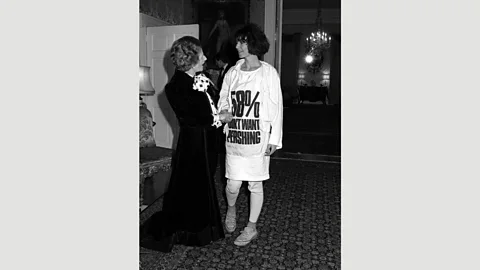 PA
PAFresh from Central St Martins art school, Hamnett first launched her brand in 1979, mixing designs based on a sexy utilitarian chic with her now-infamous slogan tees. She kicked off with Choose Life, a central Buddhist tenet inspired by her friendship with Lynne Franks, and grew the repertoire with Education Not Missiles, Worldwide Nuclear Ban Now, Peace, Save The World, Save The Sea, Clean Up Or Die, Save The Future and Vote Tactically. Significantly, most still sound pretty relevant.
In 1984, the collection was selling in 700 retail outlets across 40 countries. Hamnett, known as a ‘bad girl with integrity’, became the first person to win the British Fashion Council’s British fashion designer of the year award. Fans included Mick Jagger, Liz Taylor, Princess Diana, Boy George and Madonna; George Michael wore the Choose Life T-shirt in the video for Wham’s Wake Me Up Before You Go-Go. Early campaigns in moody monochrome were shot by influential photographers Ellen von Unwerth and Juergen Teller.
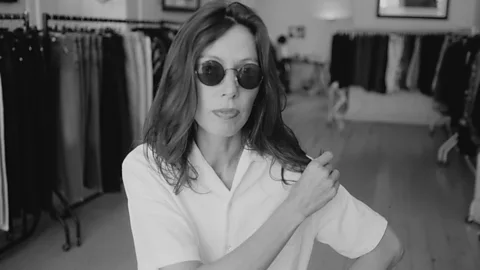 Getty
GettyBy the 1990s, the Hamnett brand had a multi-million pound turnover. They were heady days. “It was such fun, so fabulous. Fashion shows, the best hotels in the world, flying around everywhere,” says Hamnett. “And I was the original spoilt brat. I just wanted to make clothes that were exquisitely beautiful and didn’t care what they were made of. It was a time of total innocence – and, yes, ignorance. We were just having a lovely time but, in actual fact, we were all guilty.”
The crunch came in 1989, when Hamnett, then 42 and at the peak of her success, initiated research into the impact of her industry on people and the planet. “The results were devastating, a tsunami of nightmare,” she recalls. “Every single material and process had a negative impact – manmade fibres, leather tanning, viscose, dyeing and finishing. Thousands of deaths from accidental poisoning from conventional cotton agriculture; desertification and long-term contamination of aquifers.”
Distressed and angry, Hamnett tried lobbying for change, using her collections as platforms for issues that galvanised her, and badgering licensees to reduce the impact of the collections. But it was all pretty hopeless and, before long, Hamnett stepped away from fashion to focus on activism and collaborations with charities. When she relaunched the label in 2017, with re-issues of archive pieces and irreproachable ethical and sustainable credentials, it was a completely different landscape.
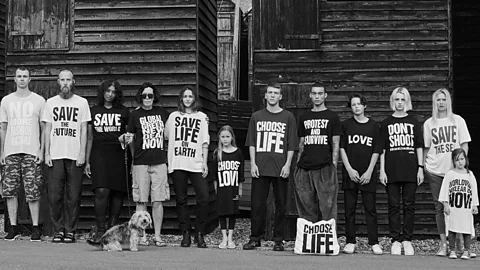 Katharine Hamnett
Katharine Hamnett“I’d been campaigning for years, I’d been successful before, I’d seen the way forward, gone to thousands of conferences on sustainability from the teeny obscure ones to the biggies,” she says, of her decision to re-launch. “I just got really fed up; it’s about show not tell.” Support came from an unexpected source: Kanye West, who requested that her archive be photographed and published as a reference for the Yeezy shoe collection that he endorses for Adidas.
Slogans still make up the brand’s DNA. Hamnett’s anti-Brexit stance has produced Fashion Hates Brexit and Cancel Brexit; those with ethical and environmental consciences have Global Green Deal Now and Save The Bees. “You can’t not read what’s written on a T-shirt,” she told The Guardian in 2018. “The slogan – three words, and lettering you can read a long way off – there’s no filter which stops it. Once you’ve read it, it’s in your brain.”
 Katharine Hamnett
Katharine HamnettWatching a 1985 interview with Hamnett on Thames TV’s Reporting London, you’re struck by a mercurial presence. Clad in an emerald-green turban and matching shantung silk top, Hamnett is an angular beauty, with huge, soulful eyes – and a biting manner. Asked whether Princess Diana would wear one of the outfits she’s showcasing, she replies, languidly: “I’d prefer to see her in that rather than quite a few of the other things that she chooses.”
Today, the 73-year-old designer wants to talk solutions – like hydrogen. “There’s a hydrogen revolution going on at the moment, as a replacement for fossil fuels,” she says, excitedly. “It’s about the only thing that gives me hope. If you burn hydrogen, all you get is water vapour. How do we cool the planet? We increase cloud cover, made from water vapour given off by photosynthesis in micro algae and trees. So, you know, transport could actually contribute to cooling the planet.”
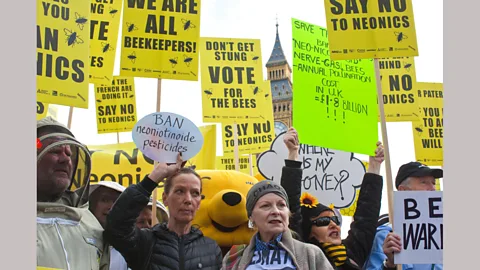 Alamy
AlamyAnd her passion for organic cotton has, if anything, grown. In 2003, Hamnett visited cotton farmers in Mali with the charity Oxfam; the memories linger. “In some French colonies, farmers were stopped from growing food, and forced to grow cotton instead. In one of the villages we visited in Mali, people were starving, [surrounded by] this perfectly fertile soil. Organic cotton uses 91% less water than conventional cotton, it’s better for biodiversity, yet only 1% of cotton used is organic. We need radical change.”
Current initiatives – including the most recent, high-profile G7 Fashion Pact – leave her cold. “[The companies] are big, they’re powerful and they want to look good. It’s a fop to the masses. If they mean what they’re saying, they need to put these clauses into their purchasing contracts: labour standards, health and safety, zero discharge of hazardous chemicals, zero carbon emissions by 2030.” The answer, in her view, is legislation, because brands are never going to do it by themselves.
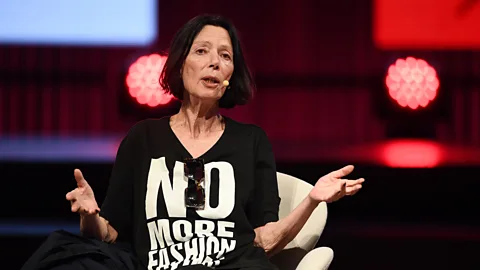 Getty Images
Getty ImagesWhile Hamnett acknowledges an awakening in the consumer (“Maybe two in five people are aware, and it’s rising, exponentially”), fashion still operates behind a carefully constructed veil of fun and frivolity. “It’s the froth on the top of a blood bath, to be honest,” says Hamnett, matter-of-factly. “It’s Pinocchio’s glitter town. That’s why we were so entranced by it. But underneath, you find a billion people, most still working in the most appalling conditions, environmental degradation. It’s got to come to an end.”
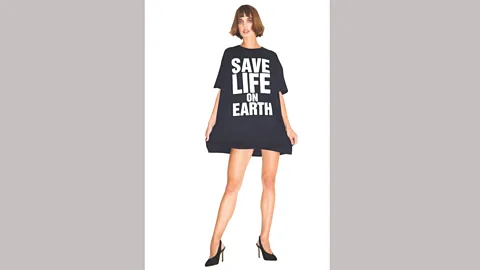 Katharine Hamnett
Katharine HamnettMeanwhile, the Katharine Hamnett London collection (tagline: ‘Buy now, wear forever’) is forging ahead; with unisex shirts and organic-cotton hoodies, it’s the ideal ambassadorial wardrobe for a conscious generation. And while Hamnett may be passionate, piercingly smart and disconcertingly forthright, she’s not without hope. Luckily, this time around, the world is ready to listen. The price of that original Pershing T-shirt may go up yet again.
